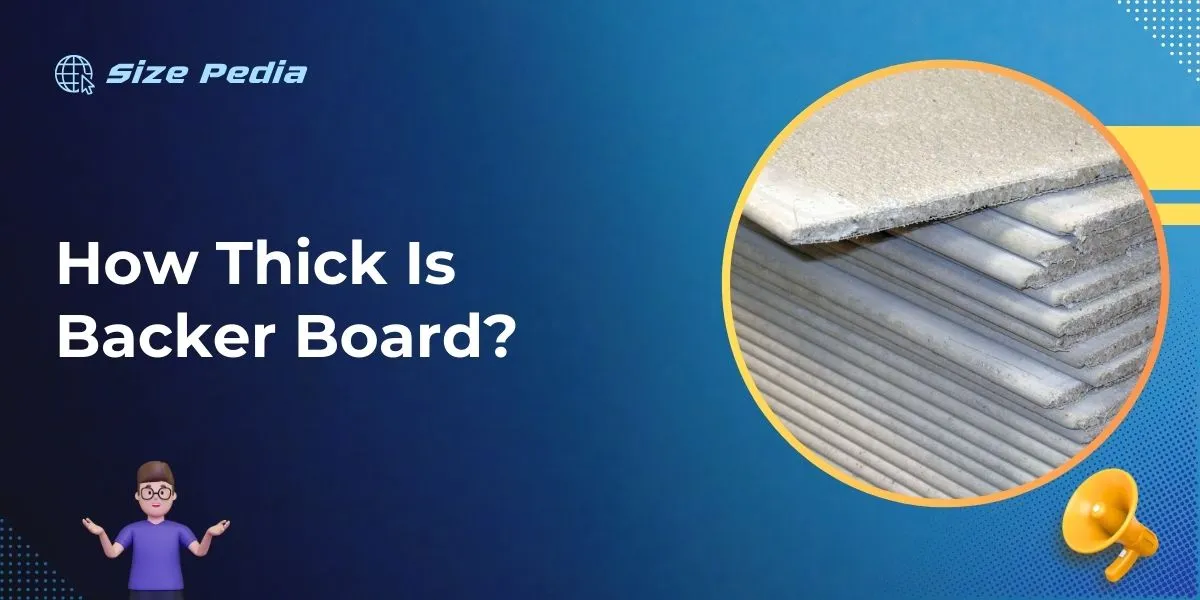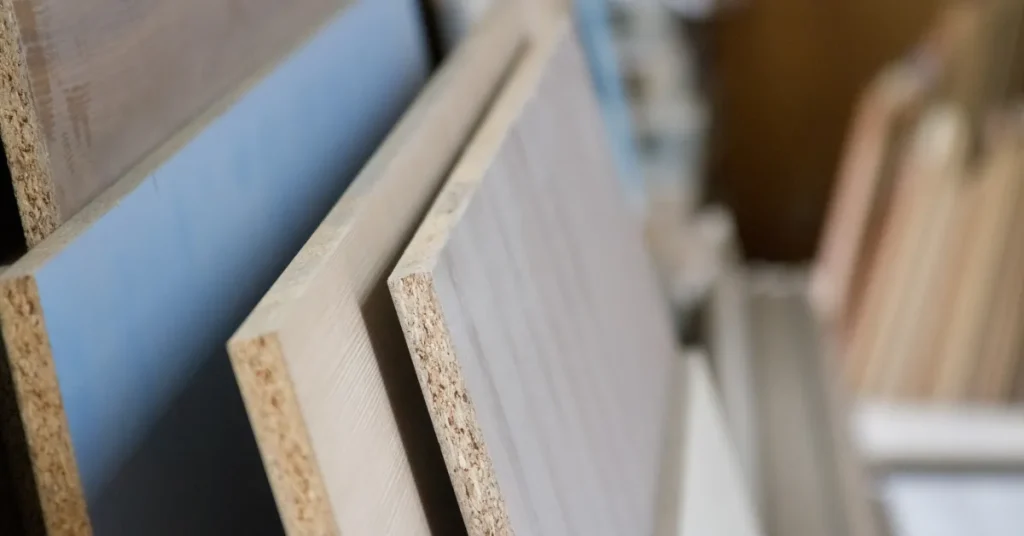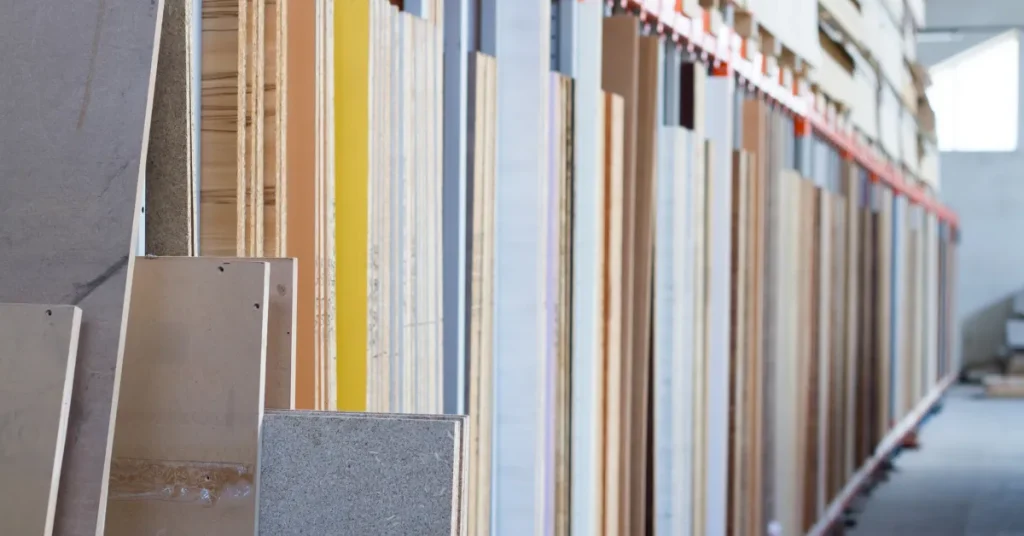Backer board typically comes in thicknesses of 1/4 inch or 1/2 inch. Specific project requirements often determine which thickness to use.
Tile installations require a sturdy base, and backer board provides just that, especially in moisture-prone areas like bathrooms and kitchens.
Known also as cement backer board, its rigidity and resistance to water make it an ideal underlayment for tile. Choosing the right thickness depends on the application and the type of flooring or wall tile you plan to install.
A quarter-inch board is common for walls and countertops where minimal height increase is desired, while the half-inch variant offers additional stability for flooring applications.
Selecting the correct thickness ensures your tile work remains level, secure, and durable over time. Always refer to manufacturer guidelines and building codes to match the requirements of your specific tiling project.

The Role Of Backer Boards In Construction
The Role of Backer Boards in Construction sets the foundation for flawless tiling work. These boards provide a sturdy and level surface, crucial for quality outputs in construction projects.
Defining The Purposes Behind Backer Board Use
- Stability: They offer a solid, non-flexing base for tiles.
- Adhesion: Backer boards ensure strong grip for tile glue.
- Uniformity: They contribute to a smooth and even tile layout.
Backer board thickness varies, addressing different needs in construction:
| Use Case | Common Thickness |
| Wall Tile Support | 1/4 inch to 1/2 inch |
| Floor Tile Support | 1/4 inch to 3/4 inch |
| Countertop Tile Support | 1/2 inch to 3/4 inch |
Vital In Waterproofing And Tiling Projects
- Moisture Barrier: Backer boards prevent water damage behind tiles.
- Longevity: They help tiles last longer by providing adequate support.
- Compatibility: Ideal for areas exposed to water, like bathrooms and kitchens.
Selecting the right thickness for the backer board is vital. Thin boards can lead to tile cracks. Thick boards provide extra protection and support. Match the board’s thickness to your project needs for optimal results.
Materials And Composition Of Backer Boards
Backer boards are a vital component in tile installations. They provide a stable and durable surface that tiles can adhere to.
Understanding the materials and composition of backer boards ensures the right type is chosen for each project.
Diverse Materials Found In Backer Boards
Backer boards come in various materials, each offering different benefits. The choice depends on the installation area and the required durability. Here are the most common types:
- Cement-based backer boards: Ideal for wet areas due to their resistance to moisture.
- Gypsum-based backer boards: Suitable for dry areas and known for their ease of cutting.
- Fiber cement backer boards: Combine the durability of cement with the resilience of cellulose fibers.
- Glass mat gypsum boards: They utilize fiberglass for increased moisture resistance.
Key Ingredients: Cement, Fibers, And Polymers
The core components in most backer boards are cement, fibers, and polymers. Each plays a crucial role:
| Ingredient | Function | Benefits |
| Cement | Serves as the main body | Provides weight and solidity |
| Fibers | Reinforce the cement matrix | Adds flexibility and prevents cracking |
| Polymers | Act as binders | Enhances strength and moisture resistance |
Standard Thickness Variety In Backer Boards

Backer boards are foundational elements in tiling projects. They provide a durable and flat surface for tiles to adhere to, whether on walls or floors.
Backer boards come in different thicknesses to suit various needs. Understanding these options ensures successful installation and long-lasting results.
Typical Measurements For Different Applications
Backer boards must match their intended use. Different situations call for specific thicknesses. Here’s a look at common sizes:
- 1/4 inch (6 mm) – Ideal for walls and residential floors.
- 1/2 inch (12 mm) – Offers more strength; great for floors.
- 5/8 inch (16 mm) – Fits heavy-duty applications.
Contrasting Thickness For Walls And Floors
Floors and walls require different backer board support. Floors handle more weight and traffic. Thus, they need thicker boards for stability. For walls, lighter boards do the job. Consider the following comparisons:
| Location | Recommended Thickness |
| Floors | 1/2 inch to 5/8 inch |
| Walls | 1/4 inch to 1/2 inch |
Choosing The Appropriate Backer Board Thickness
Choosing the correct thickness for a backer board is crucial to the success of your tiling project. Your tile’s longevity and stability hugely depend on this underlying support.
Whether you’re tiling a bathroom floor or preparing a kitchen backsplash, understanding the different thicknesses of backer board will guide you in making the best choice. Here’s what you need to know.
Fitting The Thickness To The Job
Different tiling jobs call for various backer board thicknesses. For flooring projects, a thicker board provides a sturdy base that resists flexing. These are the common thicknesses:
- 1/4 inch (6 mm) – Ideal for countertops and walls.
- 1/2 inch (12 mm) – Recommended for floors and heavy-duty applications.
- 5/8 inch (16 mm) – Used where extra strength is needed.
Match the thickness to the job. A thicker board supports heavier tiles like stone. Lighter tiles work well with thinner boards.
Impact Of Thickness On Durability And Stability
The durability and stability of your tiled surfaces depend on backer board thickness. Thicker backer boards offer more durability. Here’s how thickness affects performance:
| Thickness | Durability |
| 1/4 inch | Suitable for light use areas |
| 1/2 inch | Strong for floors and high traffic |
| 5/8 inch | Best for heavy-duty use |
Stability is also key for preventing tile and grout cracking. Opt for a thicker board in areas expecting movement or weight.
Installation Tips For Backer Boards
Installing backer boards is a key step in preparing for tile work. Proper installation ensures a durable and stable surface. Here are essential tips to help you install backer boards the right way.
Preparing Surfaces For Backer Board Deployment
Begin with a clean, level surface. Remove debris and dust that could prevent adhesion. Ensure the subfloor or wall is stable and fix any issues before laying down backer boards.
- Check Level: Use a level to ensure the surface is flat.
- Dry Fit: Lay the backer boards without adhesive to plan the layout.
- Clearance: Leave a small gap between boards for expansion.
Best Practices For Securing Backer Boards
Securing backer boards correctly is vital for the longevity of your tile surface.
- Mix Thinset: Prepare thinset mortar as per manufacturer’s instructions.
- Apply Thinset: Spread it evenly on the surface using a notched trowel.
- Place Backer Board: Press the board firmly into the thinset.
- Screw in Place: Use corrosion-resistant screws at recommended intervals.
- Seal Joints: Apply mesh tape and thinset over board joints.
Common Queries About Backer Board Thickness

Backer board is essential for tile projects. It provides a sturdy base for the tiles. Many DIY enthusiasts and professionals alike have questions regarding the thickness of backer boards.
The right thickness ensures tiles stay put and look great for years. Let’s dive into some common concerns and provide insights about it.
Can You Double Up On Backer Board For Added Strength?
Doubling up on backer board might seem a good idea to some. You want a strong surface for your tiles.
Yet, it is not always necessary or advised. Single layers of the correct thickness can offer ample strength. Doubling up could raise the floor level too much. It could even cause issues with fixture fittings.
- Check manufacturer guidelines before considering this option.
- Assess the original floor structure for sturdiness.
- Be mindful of overall floor height after installation.
Troubleshooting Issues Related To Incorrect Thickness
Incorrect backer board thickness can lead to several tile problems. These include cracking, popping, or uneven surfaces. Tackle these issues head-on.
Here’s what to do:
- Identify the problem – Are tiles cracking? Is the floor uneven?
- Measure the backer board – Use a ruler to check thickness.
- Compare with industry standards – Ensure it matches recommended sizes.
Facts Table:
| Problem | Possible Cause | Solution |
| Tile Cracking | Too thin backer board | Replace with correct thickness |
| Uneven Surface | Incorrect installation | Level and reinstall board |
| Loose Tiles | Board flex due to thickness | Use proper adhesives and techniques |
FAQs About How Thick Is Backer Board
What Thickness Of Backer Board Should I Use?
Use a 1/4 inch thick backer board for flooring and a 1/2 inch thickness for walls to ensure proper tile installation.
Should I Use 1 4 Inch Or 1 2 Inch Backer Board?
Choose 1/4 inch backer board for floors with minimal height transition. Opt for 1/2 inch for better wall rigidity and insulation.
Can You Use 1 4 Inch Cement Board On Floors?
Yes, you can use 1/4 inch cement board on floors, ideally for tile installations, ensuring a durable underlayment. Always follow the manufacturer’s guidelines for proper installation.
What Is The Difference Between Cement Board And Backer Board?
Cement board and backer board are terms often used interchangeably, but technically, cement board is a type of backer board. Backer boards can be made of various materials, whereas cement boards specifically contain cement and reinforcing fibers for durability in wet areas.
Conclusion
Summing up, backer board thickness is crucial for ensuring tile installation durability. Standard options range from 1/4 inch to 1/2 inch, tailored to your project needs.
For optimal results, choose the appropriate size, considering your project’s specifics and manufacturer recommendations.
Proper selection guarantees a stable, long-lasting surface for your tiling endeavors.
Resources:
1. https://www.nyc.gov/assets/hpd/downloads/pdfs/services/09b-gypsum-drywall-and-tile-backer-board.pdf
